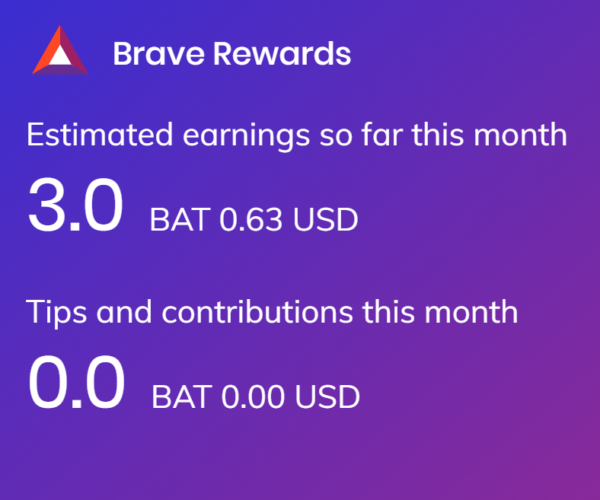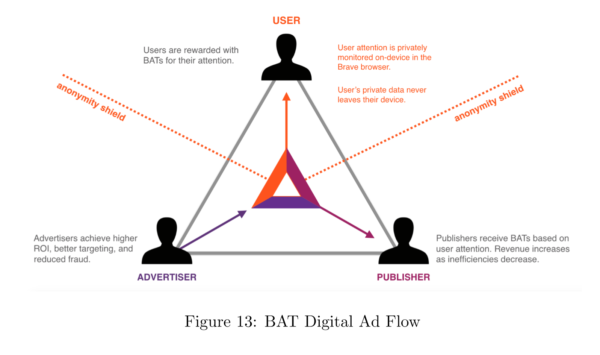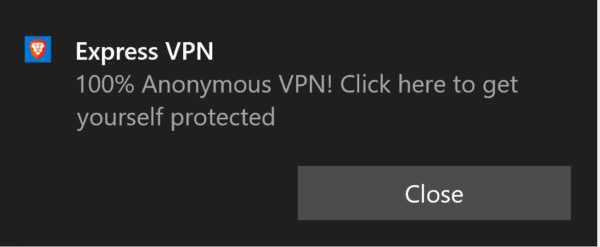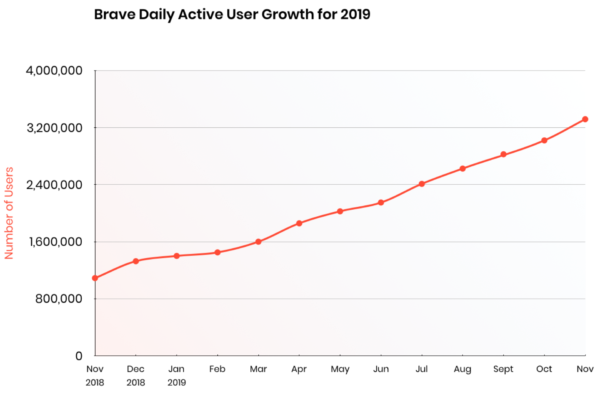Table of Contents
TL;DR:
- People are annoyed by ads, simply because they’re everywhere and can be intrusive. As a result, they’re flocking to privacy-first Browsers, Search Engines, & Ad Blockers in droves.
- One of the brightest stars in secure browsing is Brave, a browser built to protect user data above everything else.
- In recent years, Brave has rolled out a unique Advertising platform that rewards users with real money for paying attention to ads.
- For digital marketers, Brave Ads is an under-utilized option for reaching a hyper-engaged subset of users who agree to see ads. 2019 trials across industries saw average click through rates of 14%, and the platform itself grew 19% in the last quarter of 2019.
- Advertisers can learn more and request to sign up for the platform here.
The Background: Online Advertising Is Changing
People want privacy; 53% of online users are more concerned about privacy than they were a year ago. The Internet may be run on and funded by advertising, but everyday it seems that ads wallpaper more and more of the sites we browse, and it feels like it’s simply gotten overreaching.
For starters, let’s agree that people think ads are annoying, and they don’t want to be followed around online. People want companies to add value through advertising and corporate messaging. That’s why videos get shared more than 1200% times more on social. And that’s why they’re downloading ad blockers like crazy and shifting to privacy-respecting browsers and search engines in droves.
It’s still true that Google dominates the search and browser markets, but the relative industry share of “privacy-first” or cookie-less search engines like DuckDuckGo, Ecosia, and now Verizon’s OneSeach is on the rise. In parallel with the recent swell of global & national privacy regulations that sparked updates to Cookie storage policies in Safari and buzz behind new, user-focused browsers like Brave, this paints a good picture of overall consumer sentiment towards online advertising.
The Brave Browser
Brave is pathologically averse to tracking. With built-in “shields” that force all sites to use HTTPS and a TOR browser that permits users to bypass tracking & local censorship, Brave offers one of the most private browsing experiences available.
As advertisers, some might reel at the thought of limited user data in Google Analytics; it’s scary and unfamiliar territory, but it very well might be the direction of things in the post-GDPR, CCPA, or [insert next piece of privacy legislation here] era.
That said, in lieu of cookie-based tracking & advertising, Brave offers a revolutionary in-browser advertising experience.
You may have heard something about it. It’s been peppered into articles here and there, mentioned in disparate blogs and tweets, usually in contrast to Chrome, or as an off-handed tid-bit with that “aww, that’s neat. Let's put this up on the fridge” type of tone.
But dig a little deeper and you’ll see just why Brave advertising is a near-complete reversal of the current state of digital marketing, and why it’s one of the highest potential areas of growth in our industry.
How To Advertise On Brave: A Guide To Brave Ads
Overview
Let’s start with the buzzwords.
Brave Ads uses a proprietary machine learning model to serve opt-in ads to users based on browsing behavior. In exchange, users earn Basic Attention Tokens (BAT) for viewing ads.
The BAT themselves are a cryptocurrency based on the Ethereum blockchain that Brave stores in an in-browser rewards wallet for users to either save, use as tips for verified content creators, or exchange for USD.
In-Browser Brave Rewards Wallet
In practice, the result is a three-party system that mutes the advertising white noise and cuts out the middlemen that have muddled and complicated marketing for years now. It’s a system in which users, content creators, and advertisers all split the value of a viewer’s attention as seen below. For a technical breakdown of the exact model, the value flow of each BAT, and a broader summary Brave’s advertising ecosystem, see the BAT Whitepaper.
Value Flow For Basic Attention Token (B.A.T). Source: Brave Ads
Because of the financial incentives at play, and the opt-in requirement, that means we get access to a warmer, higher-caliber customer. Not to mention, our ad is much more likely to stand out on Brave, where they’re served as roll-in prompts with links to full page experiences, one-at-a-time at a set rate per hour in a format like this:
Example of A Roll-In Brave Ad
Once an ad is served, users can either close the ad by clicking ‘close,’ dismiss it and drag it away, or click into your page. In its reporting, Brave accounts for these behaviors in a few unique metrics like ‘dismissal rate’ or ‘close rate.’
Other formats are set to launch in the near future. These include branded, sponsored home pages, with images and company logos right on the browser’s main page. There are also publisher ads, which circulate on Brave’s verified content creator sites similar to the Google Display Network.

Example of A Brave Publisher Ad. Source: Brave Ads
Your ads therefore get much more of the user’s attention than it would on, say, a crowded search results page. And because it’s harder to ignore, it encourages users to actively decide if your product or service is something they want to learn more about, or if it’s something they just aren’t interested in.
How To Sign Up For Brave Ads
Now that you're familiar with the basics, here’s how to get started.
Brave Ads only recently came out of Beta, and advertisers still need to apply to use the platform. However, your campaign spend determines your qualification; currently there is a $2,500 minimum monthly budget. Advertisers at or above that spend are assigned an account representative, who helps set up and monitor the account. Advertisers below that level are put on a waitlist for a self-serve ad manager account, set to roll-out in the coming months.
The process for advertising on Brave is as follows.
-
-
- Campaigns are set-up through an application form, which collects advertiser info, campaign spend & KPI info, and creative. In the form, you provide a manager email, and set your desired spend, billing, and reporting preferences.
- Note that advertisers are not locked-in at their initial spend. They may adjust once their application is accepted.
-
-
Launch
-
-
- Once you’re approved, you’ll make the strategic call on how to target users. You can leave it all up to Brave’s machine learning algorithm, or you can select specific customer segments to target. Currently you’re able to choose from a list of audiences & categories, but the rest is up to the platform’s algorithm.
- After that, most of the maintenance changes are left to Brave to manage. You can work closely with the team on strategic & budget initiatives, but larger campaign changes happen on their end (with your approval). As discussed, ad formats are roll-in with a headline, body copy, and a link to a landing page.
-
-
Maintain
-
- Currently, there’s no definite guide to Brave best-practices, but Uproer will continue to monitor campaign performance and identify key strategies for landing page & creative tests.
- Advertisers can set account billing to CPC or CPM, and quantity discounts exist for accounts spending over $50,000 per month.
- Brave Ad Ops team and dedicated account reps conduct most of the maintenance, and the current dashboard feature is effectively “read-only.” You inform the strategy changes, but their goal is tactically to ensure ads continue to run.
What’s The Catch?
It’s not hard to see the potential benefits, but as a realist, I have to give you some grains of salt. For starters, Brave is only at 12 million users per month. While it is still growing, the market cap for your company or clients might be pretty low on the platform.
Also, best practices aren’t hashed out. There isn’t a long track record of success stories and failures to draw from, and there aren’t many resources for advertisers looking to learn how to work in Brave. Moreover, Brave hasn’t made the advertising process as clear and seamless as its larger competitors.
Finally, for privacy’s sake, reporting does not yet integrate with other platforms. User data is stored in Brave servers, which have limited visibility into much beyond browser history. And as we all know, browsing data is not always the best picture of the user behind the keyboard, especially without cookies to track, verify, and collect additional information. While Brave claims their algorithm uses other signals, it isn’t clear what exactly those are.
Brave User Growth Over 2019. Source: Brave Ads
Still, it’s a young platform, and it’s growing fast -- 19% since its 1.0 launch in November 2019. So go ahead and put that on the fridge, but if Brave isn’t on your list of “test” platforms this year, it should be. It is for us.





